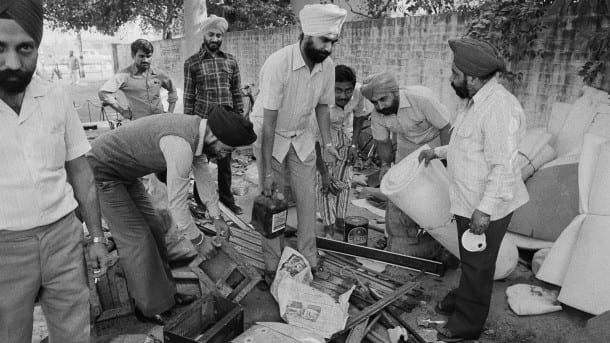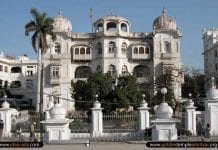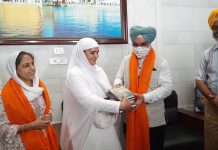Most chronicles of the 1984 anti-Sikh Pogroms focus on Delhi and Punjab. Few acknowledge Daltonganj—a typical town in Bihar (now in Jharkhand)—as a place that heavily bore the brunt of the carnage.
I know differently.
Thirty years ago, when the violence broke out on the streets of that town, I was all of 30, married, with a little girl. We lived in a joint family with my parents, three brothers, their wives, and children.
Three years earlier, the year my daughter was born, I had felt the need to stand up on my feet, and I had opened a shop of automobile spare parts in Daltonganj’s busiest area.
The whole of the town is no bigger than a Delhi neighborhood. Like much of small town India, it has a fair share of different communities, one hospital, two film theaters, and a handful of schools.
In its anonymity thrived its innocence. Until October 31, 1984.
I clearly remember it was a Wednesday. It was around four in the evening. One India-Pakistan cricket match had been abruptly canceled midway, and people huddled around their radios began spreading the message: “The BBC said that Indira Gandhi was assassinated this morning.” Not until 4:50, when the Urdu news report was transmitted via All India Radio, did we know that it wasn’t a rumor. The prime minister had been murdered.
It was the last day of Chhath Puja, so I was expecting one of my Hindu friends to visit me. This friend—let’s call him Ashok—came every year to give me holy prashad. A couple of hours had passed by—and though people were in a state of shock, everything seemed pretty much like any other day. The market was closing down and people were returning to their families.
When Ashok arrived, I was preparing to leave, too. “Don’t go home tonight. It’s not safe,” he told me. A medical shop close to the hospital run by a Sikh had apparently been looted. Another Sikh laundryman had been attacked.
Who did it, I did not know. What was going to happen, I could not tell.
I somewhat panicked. A couple of my Hindu friends got together and suggested I should stay the night with my friend Kamlesh, who lived right across the street from my shop, instead of returning home to my family. I conceded.
The next morning, mayhem broke out. As I peeped through the windows of my friend’s house, I saw a mob of some 600 people break into the wooden door of my shop and loot it. They carried rods and kerosene. The inhumanity was frightening. Some people who I would often sip tea with in the evenings were right there, in front of my eyes, devastating my livelihood. My brother’s shop next door was looted and set aflame.
The whole day, I hid behind the windows, barely knowing how long would this go on; barely understanding how were they, we—the Sikhs—at fault. Indira Gandhi had been killed by her two Sikh bodyguards, but how did it justify attacking innocent Sikhs who are, like everybody else, just trying to earn their living?
I did not know about my family’s whereabouts for hours. Eventually, the telephone lines improved and I could use my friend’s phone to find out that they were being protected by one of our neighbors.
Later that day, my friend Kamlesh received a threatening phone call; people were saying he had hid a Sikh in his house. Kamlesh’s neighbor, a fearless Hindu, offered to help. The same night at 11, I removed my turban, opened my hair, covered myself in a white sheet and moved over to his neighbor’s house.
Sikhs cover their hair out of respect for god’s creation. That is our identity. As a Sikh, it was no less than demeaning to be forced in a situation to let it down.
On Nov. 2, a curfew was declared. The looting and the killing nonetheless continued. Another day passed. The army arrived. On Nov. 4, the curfew ended, but the army men stayed on for several days afterward.
I was clueless about how the rest of the town fared. I was pained with rage and agony. For two hours, when the curfew was lifted, I joined hordes of other Sikh men at the police station, and told a cop: “I am one of the victims and I want to have a look at my shop.” The cop who had been patrolling the areas asked me: “Which one was yours?” I told him—only to be informed the shop was completely emptied. I insisted on seeing it for myself.
I don’t know what I was thinking. Instead of returning home, I went with the cops to my shop. I opened what was left of a broken door. Three or four stray dogs greeted us, huddled inside the tiny space, looted of my once simple life.
I somehow got rid of them, sat right there, and cried and cursed endlessly. I found a sack and collected whatever items remained. I asked Kamlesh to keep them for me, but he declined because the army had announced that they would be searching the rioters’ homes for their bounty. That, I think, never happened.
After four days, I returned home with the sack. My wife and mother, who had little hopes of seeing me again, cried and cried–as they would for many days to come. There were several mob attacks on my house during the course of these four days, but our longtime neighbors—a joint family of Rajputs, just like ours—saved us.
The loss all around was unprecedented. The nearby Gurdwara was strewn in blood—and those marks have barely rubbed off to this day. The head priest was slashed to death—and his young children were beaten and harassed. The broken windowpanes of the Gurdwara remain, a bitter memory to the stone pelting that went on for hours on the holy shrine.
In Daltonganj, countless Sikh men were beaten up. A dozen died. Some houses were stoned; others set ablaze. Some local Sikh who were traveling out of the town were dragged out of trains and killed. The hospital refused to admit the injured, unless men cut their hair. Turban-wearing Sikhs had to make a choice: cut your hair or not get medical care. In the wake of the rampage, several Hindus, too, could not leave their homes.
Thereafter, a few Sikh families sought help from their related families in Punjab and left the town. I, too, went and found a place in Amritsar, but I could not convince my family to relocate. My father—who had witnessed his father’s killing during India’s partition in 1947—was hellbent on the whole family migrating together, or not migrating at all. My mother had lost her brother in the brutal attacks on Hindus and Muslims and Sikhs alike in 1947. Any form of killing is wrong—but I can attest it’s worse when the nation corners one single community.
In his first-person accounts from Sikhs across the nation, Jarnail Singh’s book, I Accuse, captures the anguish of a community that is still struggling to forgive and forget—given there has been no justice till this date. Across the nation, more than 8,000 Sikhs were killed, women were raped, burnt alive, homes brought down, children forced to grow up. These have affected the psyche of the people permanently.
Thirty years have passed, but the memory of the riots doesn’t fail me. In some ways, I have put it behind and moved on. In some ways, I have not. I still feel vulnerable to be living among many of those people. The pain, the trauma, the betrayal of the government, the suspicion of my friends, and the mistrust in justice—these cannot be taken away from me. It isn’t easy to forget. And so, I never will.





